Abstract
To determine the role of recently recognized enteropathogens in childhood diarrhea in China, 221 children with diarrhea and 108 controls seen at the Beijing Children's Hospital were studied during April and May 1989. Stools were examined for ova, parasites, and rotavirus, cultured for bacterial pathogens, and probed for enterotoxigenic Escherichia coli (ETEC), enteroinvasive E. coli (EIEC), enterohemorrhagic E. coli (EHEC), and enteropathogenic adherence factor-positive (EAF+) E. coli. Pathogens were identified in 56.5% of children with diarrhea and 43.5% of controls (P = 0.04). Detection of enteropathogens was significantly greater in patients examined within 1 week of symptom onset (65%) than in patients examined later (39%; P = 0.01). ETEC was the most frequently detected pathogen in children with diarrhea, accounting for 20% of the cases. Other agents identified in patients included the following: salmonellae, 12%; rotavirus, 7%; EIEC, 7%; EHEC, 7%; members of the Aeromonas hydrophila group, 6%; EAF+ E. coli, 5%; Ascaris lumbricoides, 3%; shigellae, 3%; campylobacters, 2%; and Vibrio spp., 0.5%. The isolation rates of salmonellae (P = 0.02), EAF+ E. coli (P = 0.04), and mixed pathogens (P = 0.05) were significantly greater for diarrhea patients than for controls. Resistance to multiple antimicrobial agents occurred in 39% of the Salmonella isolates, 22% of the Aeromonas isolates, and 17% of the Shigella isolates. Multiresistant salmonellae (P = 0.05) and shigellae were recovered from diarrheal stools only. Ciprofloxacin, cefotaxime, and imipenem were the only agents tested to which all bacterial isolates were susceptible in vitro. These results suggest that both traditional and newly recognized agents are important causes of childhood diarrhea in Beijing and that therapy may be complicated by indigenous antimicrobial resistance.
Full text
PDF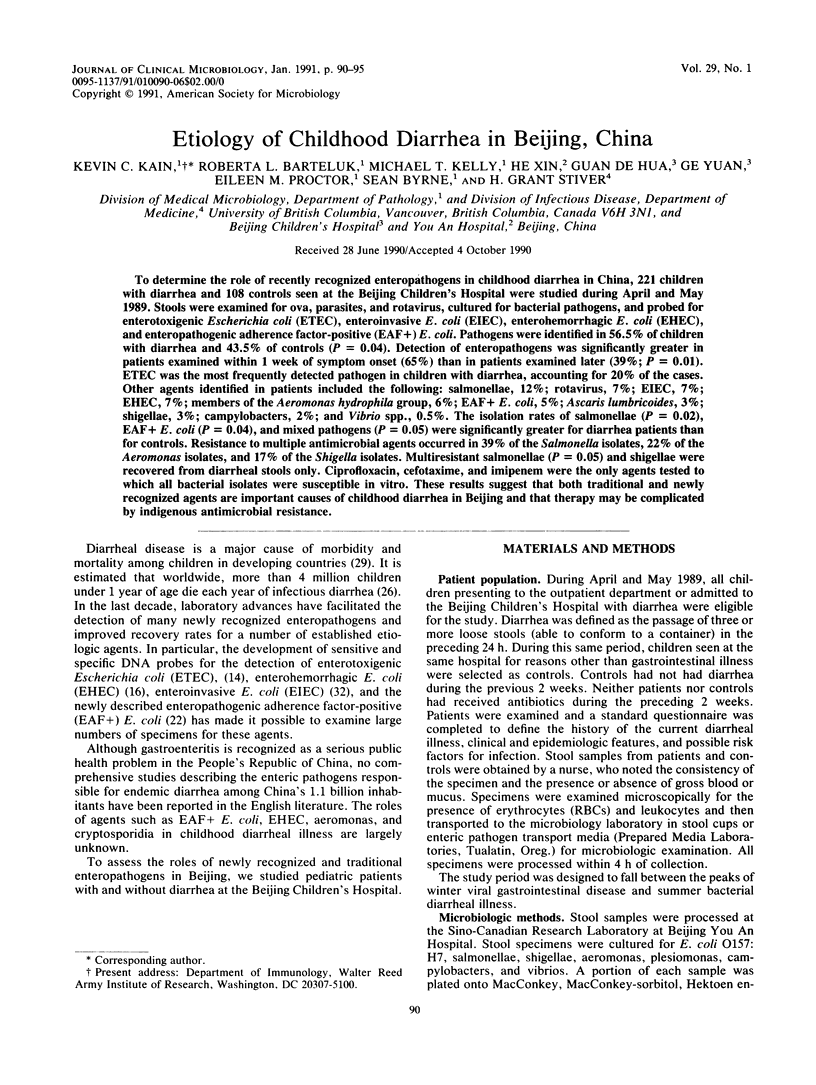
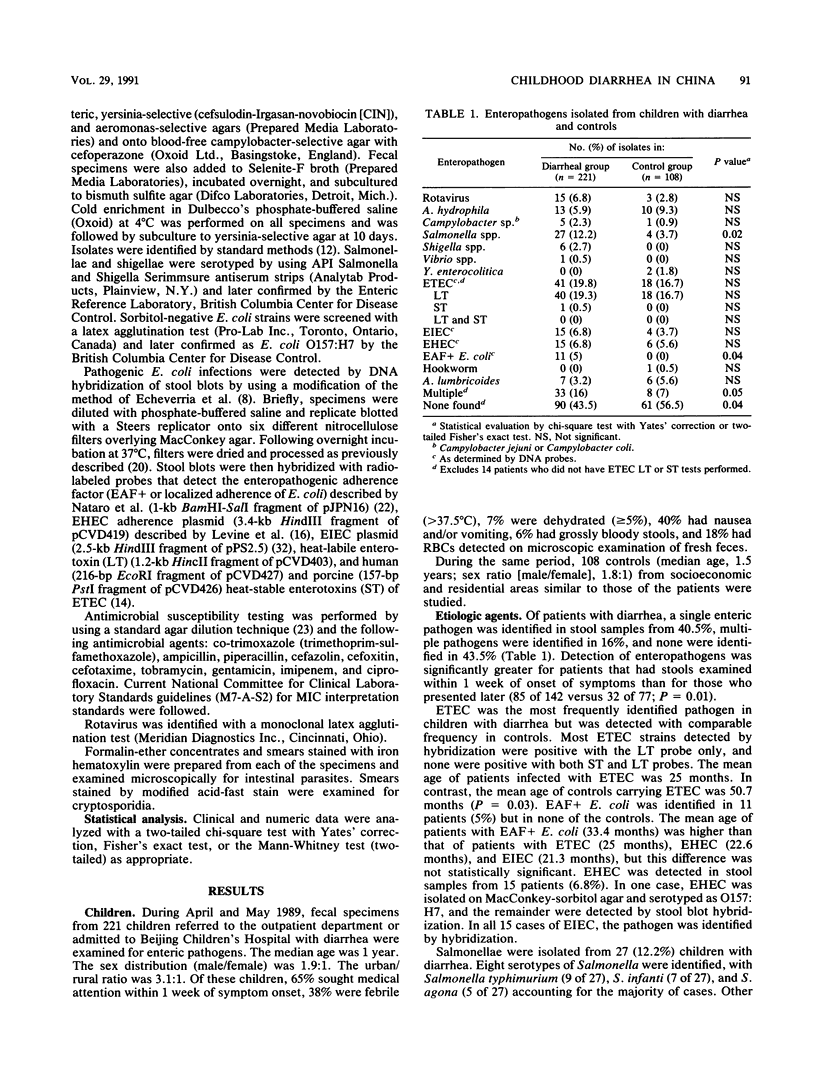
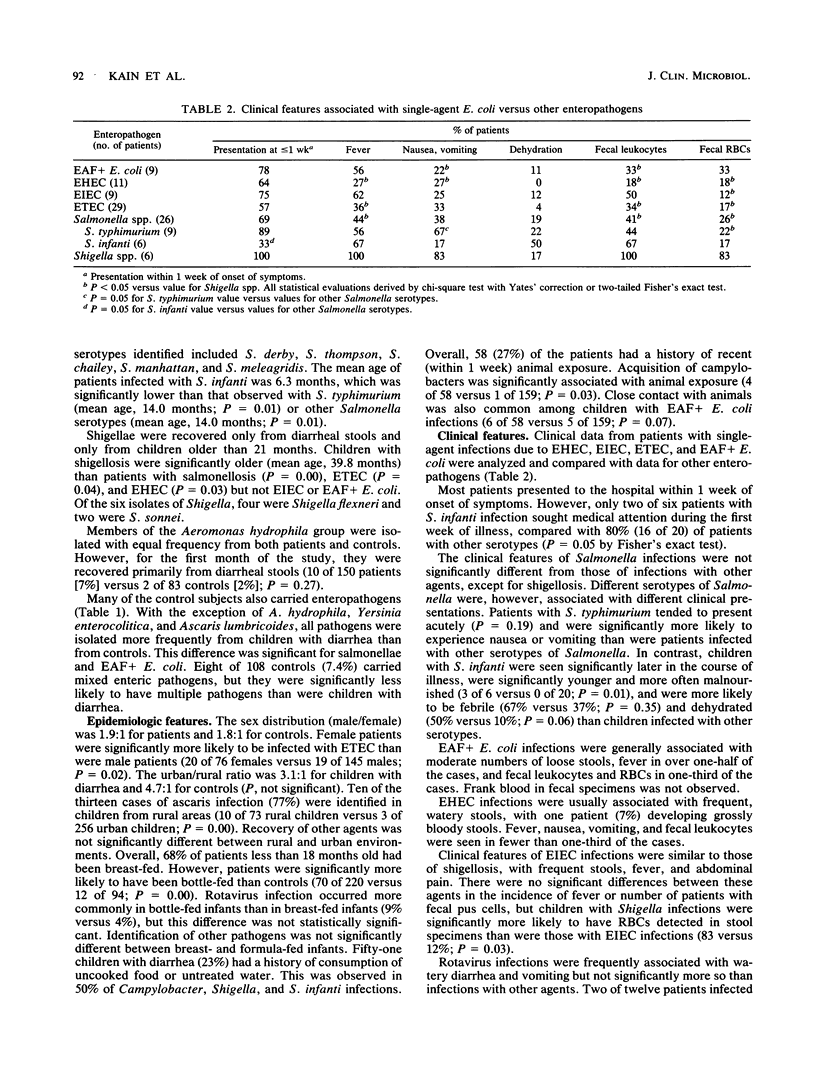
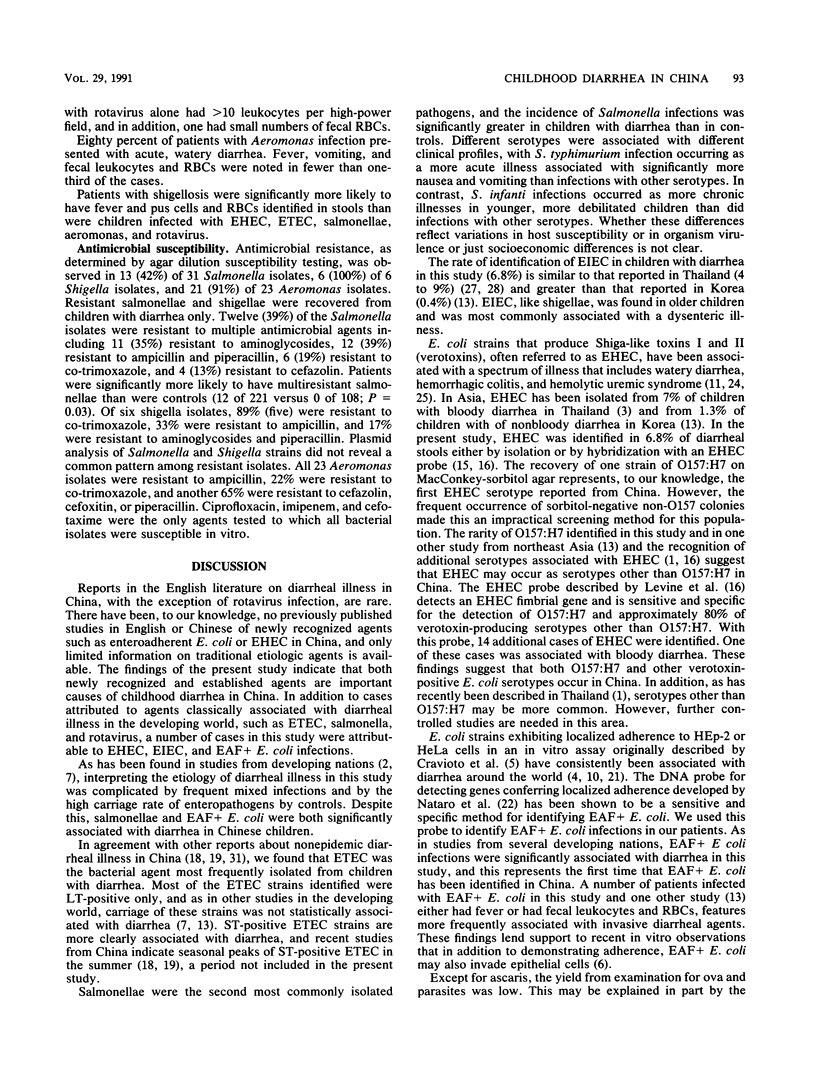
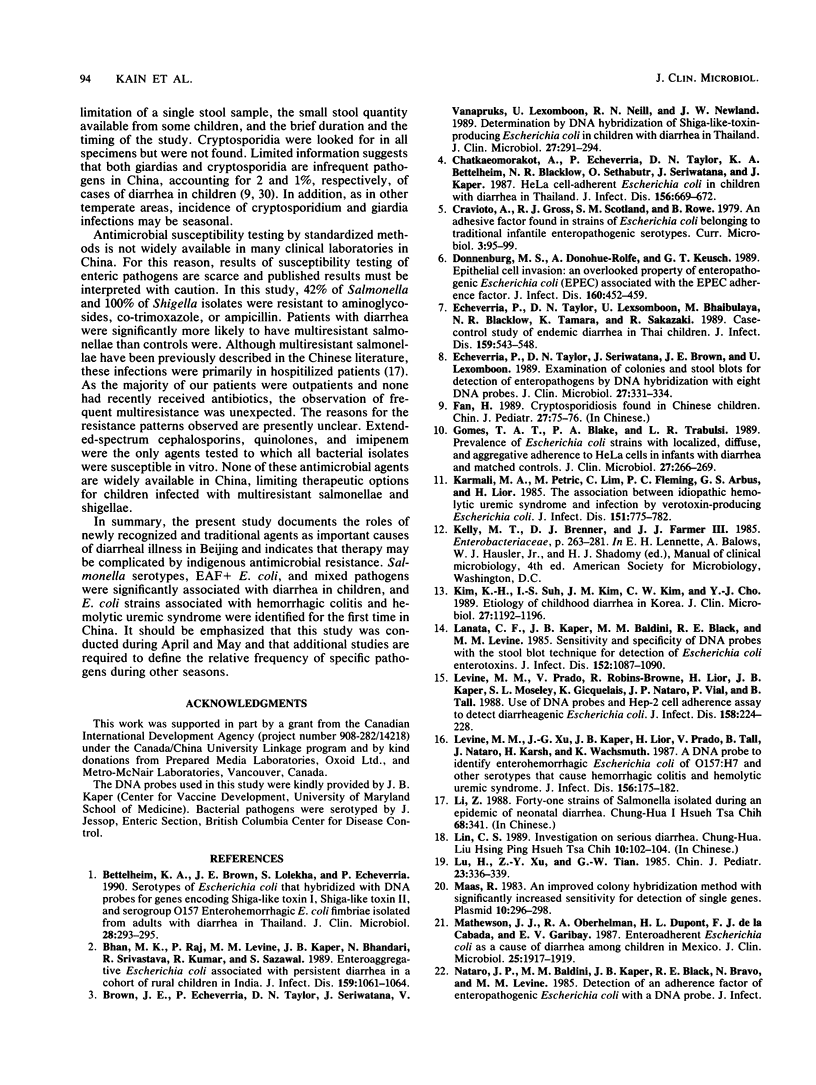
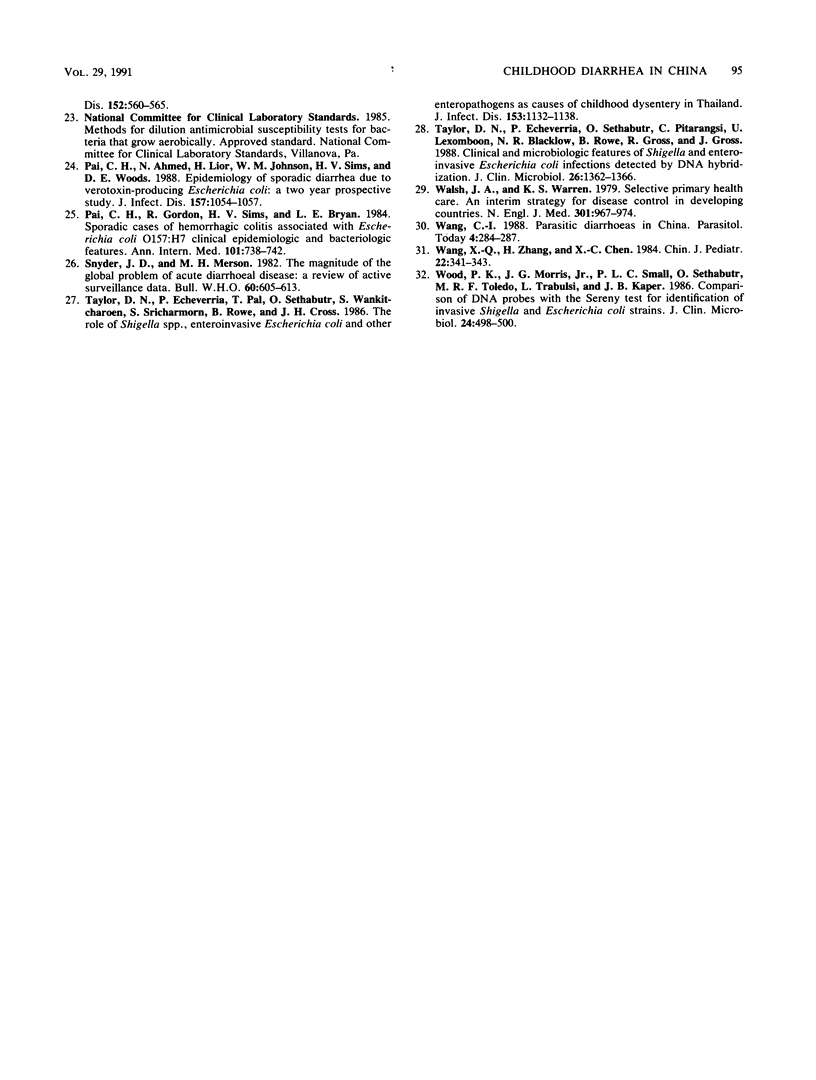
Selected References
These references are in PubMed. This may not be the complete list of references from this article.
- Bettelheim K. A., Brown J. E., Lolekha S., Echeverria P. Serotypes of Escherichia coli that hybridized with DNA probes for genes encoding Shiga-like toxin I, Shiga-like toxin II, and serogroup O157 enterhemorrhagic E. coli fimbriae isolated from adults with diarrhea in Thailand. J Clin Microbiol. 1990 Feb;28(2):293–295. doi: 10.1128/jcm.28.2.293-295.1990. [DOI] [PMC free article] [PubMed] [Google Scholar]
- Bhan M. K., Raj P., Levine M. M., Kaper J. B., Bhandari N., Srivastava R., Kumar R., Sazawal S. Enteroaggregative Escherichia coli associated with persistent diarrhea in a cohort of rural children in India. J Infect Dis. 1989 Jun;159(6):1061–1064. doi: 10.1093/infdis/159.6.1061. [DOI] [PubMed] [Google Scholar]
- Brown J. E., Echeverria P., Taylor D. N., Seriwatana J., Vanapruks V., Lexomboon U., Neill R. N., Newland J. W. Determination by DNA hybridization of Shiga-like-toxin-producing Escherichia coli in children with diarrhea in Thailand. J Clin Microbiol. 1989 Feb;27(2):291–294. doi: 10.1128/jcm.27.2.291-294.1989. [DOI] [PMC free article] [PubMed] [Google Scholar]
- Chatkaeomorakot A., Echeverria P., Taylor D. N., Bettelheim K. A., Blacklow N. R., Sethabutr O., Seriwatana J., Kaper J. HeLa cell-adherent Escherichia coli in children with diarrhea in Thailand. J Infect Dis. 1987 Oct;156(4):669–672. doi: 10.1093/infdis/156.4.669. [DOI] [PubMed] [Google Scholar]
- Cheng-I W. Parasitic diarrhoeas in China. Parasitol Today. 1988 Oct;4(10):284–287. doi: 10.1016/0169-4758(88)90020-8. [DOI] [PubMed] [Google Scholar]
- Donnenberg M. S., Donohue-Rolfe A., Keusch G. T. Epithelial cell invasion: an overlooked property of enteropathogenic Escherichia coli (EPEC) associated with the EPEC adherence factor. J Infect Dis. 1989 Sep;160(3):452–459. doi: 10.1093/infdis/160.3.452. [DOI] [PubMed] [Google Scholar]
- Echeverria P., Taylor D. N., Lexsomboon U., Bhaibulaya M., Blacklow N. R., Tamura K., Sakazaki R. Case-control study of endemic diarrheal disease in Thai children. J Infect Dis. 1989 Mar;159(3):543–548. doi: 10.1093/infdis/159.3.543. [DOI] [PubMed] [Google Scholar]
- Echeverria P., Taylor D. N., Seriwatana J., Brown J. E., Lexomboon U. Examination of colonies and stool blots for detection of enteropathogens by DNA hybridization with eight DNA probes. J Clin Microbiol. 1989 Feb;27(2):331–334. doi: 10.1128/jcm.27.2.331-334.1989. [DOI] [PMC free article] [PubMed] [Google Scholar]
- Gomes T. A., Blake P. A., Trabulsi L. R. Prevalence of Escherichia coli strains with localized, diffuse, and aggregative adherence to HeLa cells in infants with diarrhea and matched controls. J Clin Microbiol. 1989 Feb;27(2):266–269. doi: 10.1128/jcm.27.2.266-269.1989. [DOI] [PMC free article] [PubMed] [Google Scholar]
- Karmali M. A., Petric M., Lim C., Fleming P. C., Arbus G. S., Lior H. The association between idiopathic hemolytic uremic syndrome and infection by verotoxin-producing Escherichia coli. J Infect Dis. 1985 May;151(5):775–782. doi: 10.1093/infdis/151.5.775. [DOI] [PubMed] [Google Scholar]
- Kim K. H., Suh I. S., Kim J. M., Kim C. W., Cho Y. J. Etiology of childhood diarrhea in Korea. J Clin Microbiol. 1989 Jun;27(6):1192–1196. doi: 10.1128/jcm.27.6.1192-1196.1989. [DOI] [PMC free article] [PubMed] [Google Scholar]
- Lanata C. F., Kaper J. B., Baldini M. M., Black R. E., Levine M. M. Sensitivity and specificity of DNA probes with the stool blot technique for detection of Escherichia coli enterotoxins. J Infect Dis. 1985 Nov;152(5):1087–1090. doi: 10.1093/infdis/152.5.1087. [DOI] [PubMed] [Google Scholar]
- Levine M. M., Prado V., Robins-Browne R., Lior H., Kaper J. B., Moseley S. L., Gicquelais K., Nataro J. P., Vial P., Tall B. Use of DNA probes and HEp-2 cell adherence assay to detect diarrheagenic Escherichia coli. J Infect Dis. 1988 Jul;158(1):224–228. doi: 10.1093/infdis/158.1.224. [DOI] [PubMed] [Google Scholar]
- Levine M. M., Xu J. G., Kaper J. B., Lior H., Prado V., Tall B., Nataro J., Karch H., Wachsmuth K. A DNA probe to identify enterohemorrhagic Escherichia coli of O157:H7 and other serotypes that cause hemorrhagic colitis and hemolytic uremic syndrome. J Infect Dis. 1987 Jul;156(1):175–182. doi: 10.1093/infdis/156.1.175. [DOI] [PubMed] [Google Scholar]
- Lin C. S. [Investigation on serious diarrhea]. Zhonghua Liu Xing Bing Xue Za Zhi. 1989 Apr;10(2):102–104. [PubMed] [Google Scholar]
- Maas R. An improved colony hybridization method with significantly increased sensitivity for detection of single genes. Plasmid. 1983 Nov;10(3):296–298. doi: 10.1016/0147-619x(83)90045-8. [DOI] [PubMed] [Google Scholar]
- Mathewson J. J., Oberhelman R. A., Dupont H. L., Javier de la Cabada F., Garibay E. V. Enteroadherent Escherichia coli as a cause of diarrhea among children in Mexico. J Clin Microbiol. 1987 Oct;25(10):1917–1919. doi: 10.1128/jcm.25.10.1917-1919.1987. [DOI] [PMC free article] [PubMed] [Google Scholar]
- Pai C. H., Ahmed N., Lior H., Johnson W. M., Sims H. V., Woods D. E. Epidemiology of sporadic diarrhea due to verocytotoxin-producing Escherichia coli: a two-year prospective study. J Infect Dis. 1988 May;157(5):1054–1057. doi: 10.1093/infdis/157.5.1054. [DOI] [PubMed] [Google Scholar]
- Pai C. H., Gordon R., Sims H. V., Bryan L. E. Sporadic cases of hemorrhagic colitis associated with Escherichia coli O157:H7. Clinical, epidemiologic, and bacteriologic features. Ann Intern Med. 1984 Dec;101(6):738–742. doi: 10.7326/0003-4819-101-6-738. [DOI] [PubMed] [Google Scholar]
- Snyder J. D., Merson M. H. The magnitude of the global problem of acute diarrhoeal disease: a review of active surveillance data. Bull World Health Organ. 1982;60(4):605–613. [PMC free article] [PubMed] [Google Scholar]
- Taylor D. N., Echeverria P., Pál T., Sethabutr O., Saiborisuth S., Sricharmorn S., Rowe B., Cross J. The role of Shigella spp., enteroinvasive Escherichia coli, and other enteropathogens as causes of childhood dysentery in Thailand. J Infect Dis. 1986 Jun;153(6):1132–1138. doi: 10.1093/infdis/153.6.1132. [DOI] [PubMed] [Google Scholar]
- Taylor D. N., Echeverria P., Sethabutr O., Pitarangsi C., Leksomboon U., Blacklow N. R., Rowe B., Gross R., Cross J. Clinical and microbiologic features of Shigella and enteroinvasive Escherichia coli infections detected by DNA hybridization. J Clin Microbiol. 1988 Jul;26(7):1362–1366. doi: 10.1128/jcm.26.7.1362-1366.1988. [DOI] [PMC free article] [PubMed] [Google Scholar]
- Walsh J. A., Warren K. S. Selective primary health care: an interim strategy for disease control in developing countries. N Engl J Med. 1979 Nov 1;301(18):967–974. doi: 10.1056/NEJM197911013011804. [DOI] [PubMed] [Google Scholar]
- Wood P. K., Morris J. G., Jr, Small P. L., Sethabutr O., Toledo M. R., Trabulsi L., Kaper J. B. Comparison of DNA probes and the Sereny test for identification of invasive Shigella and Escherichia coli strains. J Clin Microbiol. 1986 Sep;24(3):498–500. doi: 10.1128/jcm.24.3.498-500.1986. [DOI] [PMC free article] [PubMed] [Google Scholar]


